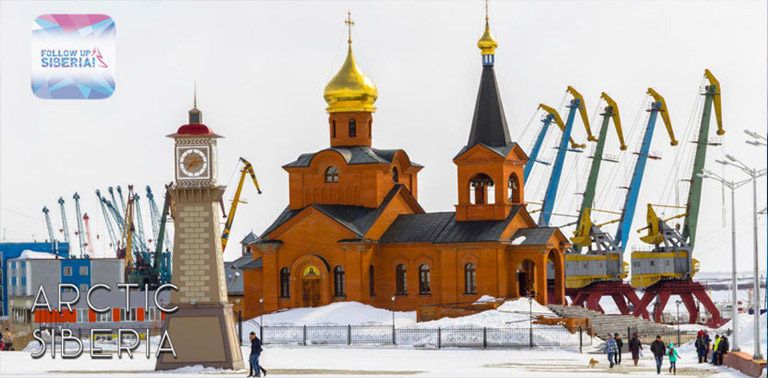
Adventure in the Arctic Siberia
When thinking about traveling in Siberia, the first and maybe only thing that comes in mind, is the Trans-Siberian Railway. Running 9 289 kilometers through Russia from Moscow all the way to Vladivostok by the Sea of Japan, it’s the longest railway line in the whole world, and a ride through Siberia along it is on many backpackers bucket list, us included. But did you know that the Trans-Siberian Railway is actually running through southern parts of Siberia only?
Above this railway is the huge and very sparsely populated northern Siberia, land of arctic tundra and taiga, permafrost, mountains, glaziers, lakes and deep rives. Land with flora and fauna that is adjusted to the harsh conditions, and home to several indigenous peoples since thousands of years. Land with endless natural resources and territory where permafrost and ice have preserved remains of prehistoric species like mammoths and cave lions.
In the middle of all this wilderness runs the Yenisei river, midmost of the three great Siberian rivers, and the one that splits Siberia into two major geographical zones; West Siberian Plain in the west and Central Siberian Plateau in the east. By that river, way above the arctic circle, just few hundred kilometers from the arctic sea, in the far north of Russia we got to spent amazing three days with the Follow up Siberia project. Not your typical weekend getaway for sure, as the northern part of the Krasnoyarsk region, the Taymyr Peninsula, is an isolated district even in Siberian scale. In this post we introduce the highs and lows of this remote corner of the world. Check out also the post about how did we end up exploring Siberia in the first place.
The Arctic Siberia
Living in northern Siberia, above the Arctic Circle, is for sure not for the weak. In Taymyr Peninsula the winters last for 280 days, which is over 9 months. In the mid-winter the sun does not rise at all in 45 days; this is a natural phenomena called the polar night. During that time it’s basically dark all the time, except for the bit brighter, grey moments around noon every day. Winters in northern Siberia are also very cold, it can be under -30C for several months in a row, and even -60C is not unheard of. And then there is the snow, several meters of it falls down every winter. Combined with the strong winds, that are typical for this area, you get violent, freezing snowstorms that force people to stay inside. The area is also part of the continuous permafrost zone, meaning that the soil is frozen around the year.
On the other hand, the summer in these arctic areas comes with the polar day; a nearly 70 days long period when the sun does not set at all. Arctic summer is short, but it can be really warm, and for a moment the snow-covered tundra turns into beds of wild flowers.
Norilsk, an arctic city in the shades of factories
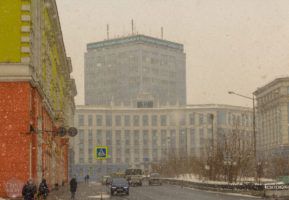 Norilsk is an isolated industrial city, situated in the northernmost part of Krasnoyarsk Krai region, the Taymyr Peninsula. The arctic, harsh climate makes this area off-putting for living, but the mineral resources it holds make it invaluable. The first large scale mineral reserves of Taymyr were discovered in the early 20th century, and soon after that the mining operations started. This led to building metallurgic factories and a whole city for all the workers and their families.
Norilsk is an isolated industrial city, situated in the northernmost part of Krasnoyarsk Krai region, the Taymyr Peninsula. The arctic, harsh climate makes this area off-putting for living, but the mineral resources it holds make it invaluable. The first large scale mineral reserves of Taymyr were discovered in the early 20th century, and soon after that the mining operations started. This led to building metallurgic factories and a whole city for all the workers and their families.
The official founding year of Norilsk is 1935, but the story begins in 1921, when the first house of the city was built. Geologist Nikolai Urvantsev stayed in this house through a rough winter, and proved that it’s possible to build houses and live in this extremely cold area. To build the mines and factories, as well as the city itself, a gulag labor camp was set in the area in 1935. Called Norillag, the Norilsk Corrective Labor Camp existed until 1956 and estimate of the total number of inmates during those two decades is around 400 000.
The city of Norilsk grew hand in hand with the metallurgic industry, and is home to around 180 000 permanent residents today. The high-rise houses of Norilsk are built in a wind protective layout, turning their backs to the wind and snowstorms, and painted with vivid colors to brighten up the otherwise so gray-scaled environment. The houses are also built on piles, above the ground level. This is because of the permafrost: as every house is a source of heat, they would melt the swampy soil under them and start to fall down, if built straight on the ground. Permafrost is also the reason why all the pipelines are running above the ground, giving the city streets a very industrialized look.
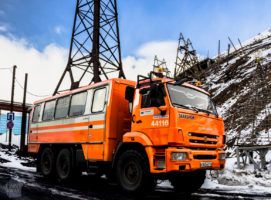 Norilsk is stated to be one of the most polluted cities in the world. The main source of pollution is the smelting of nickel ore with high sulfur content, and during the decades the region has suffered from acid rains and heavy smog. The environmental situation is fortunately getting better after a nickel smelter, that was located within the city limits, was shut down in 2016. But still, if pure nature is what you are looking for, Norilsk is not the place to stay in. Instead, the Putorana Plateau not that far away is a UNESCO World Heritage listed nature reserve, with isolated mountain range, pristine taiga and untouched lakes and rivers. A hike in Putorana Plateu would surely be a wonderful experience!
Norilsk is stated to be one of the most polluted cities in the world. The main source of pollution is the smelting of nickel ore with high sulfur content, and during the decades the region has suffered from acid rains and heavy smog. The environmental situation is fortunately getting better after a nickel smelter, that was located within the city limits, was shut down in 2016. But still, if pure nature is what you are looking for, Norilsk is not the place to stay in. Instead, the Putorana Plateau not that far away is a UNESCO World Heritage listed nature reserve, with isolated mountain range, pristine taiga and untouched lakes and rivers. A hike in Putorana Plateu would surely be a wonderful experience!
Dudinka, a pocket-sized port town
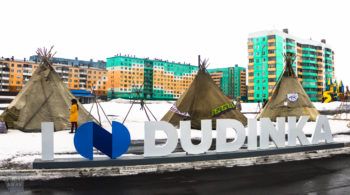 The port town of Dudinka is situated by the Yenisei river, 90 kilometers west from Norilsk. The port is a gateway to the Northern Sea Route, and thus invaluable for Norilsk and Nornickel. Majority of all the goods and fuel used in Norilsk and Dudinka is brought via Dudinka port, and the metals produced in Nornickel factories are delivered to global markets through the port. The waterway is kept open year around with the help of icebreakers; Nornickel has a fleet of 6 ice-class vessels that keep the river and sea route usable. Dudinka port actually is the only arctic port in the world that is operating year around.
The port town of Dudinka is situated by the Yenisei river, 90 kilometers west from Norilsk. The port is a gateway to the Northern Sea Route, and thus invaluable for Norilsk and Nornickel. Majority of all the goods and fuel used in Norilsk and Dudinka is brought via Dudinka port, and the metals produced in Nornickel factories are delivered to global markets through the port. The waterway is kept open year around with the help of icebreakers; Nornickel has a fleet of 6 ice-class vessels that keep the river and sea route usable. Dudinka port actually is the only arctic port in the world that is operating year around.
Unlike Norilks, Dudinka has a long history before the mining in the area started. It used to be a winter settlement, founded already back in 1667. Nowadays there are around 23 000 residents in the city, and it’s the administrative center of Taymyrsky Dolgano-Nenetsky District. The Taymyr Regional Museum is located in Dudinka, as well as the Taymyr Folk Arts Center, that was established to preserve traditional culture of the indigenous peoples of Taymyr area.
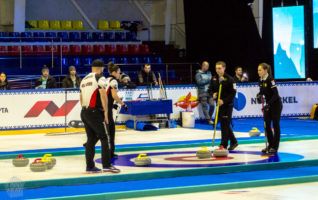 When we visited Dudinka, the city was hosting the World Curling Tour Arctic Cup tournament. Arranged in the Taimyr Ice Arena, the tournament collected top players from around the world to compete in mixed doubles. We got to participate in the opening ceremony of the tournament, which was a very impressive and well organized show! The main goal of this northernmost international curling tournament of the world is to make the sport of curling more popular in the region, and to overall support sports. There is actually even a curling school in Dudinka, where over 100 people, from kids to seniors train this interesting sport.
When we visited Dudinka, the city was hosting the World Curling Tour Arctic Cup tournament. Arranged in the Taimyr Ice Arena, the tournament collected top players from around the world to compete in mixed doubles. We got to participate in the opening ceremony of the tournament, which was a very impressive and well organized show! The main goal of this northernmost international curling tournament of the world is to make the sport of curling more popular in the region, and to overall support sports. There is actually even a curling school in Dudinka, where over 100 people, from kids to seniors train this interesting sport.
Indigenous peoples of Taymyr
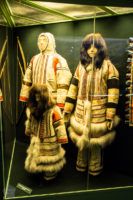 For ages, the Taymyr Peninsula has been inhabited by the Dolgans, the Nenets, the Enets, the Nganasans and the Evenks. These indigenous peoples have a lot in common, and still today some of them maintain the traditional lifestyle of reindeer breeding and fishing, and preserve traditional crafts and folklore.
For ages, the Taymyr Peninsula has been inhabited by the Dolgans, the Nenets, the Enets, the Nganasans and the Evenks. These indigenous peoples have a lot in common, and still today some of them maintain the traditional lifestyle of reindeer breeding and fishing, and preserve traditional crafts and folklore.
According to studies, the first nomadic northern people came in the banks of Yenisei river in Taymyr area from south around 8 000 years ago. They were hunters and reindeer herders, and had shamanistic beliefs, respecting the land and its resources. During Soviet era most of the indigenous people were victims of collectivism policy; they were forced to settle in villages, which led to fading of their traditional culture and languages.
Museum tours and factory excursions
During the Follow up Siberia weekend we got to visit in bunch of interesting places in Norilsk and Dudinka area. In Norilsk Museum and Taymyr Regional Museum in Dudinka we learned a lot about the history and environment of the region.
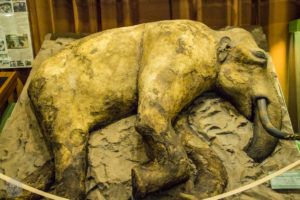 In Taymyr Regional Museum we even got to see the preserved remains of the Sopkarga mammoth, also called Zhenia. This huge mammal was found by an 11 years old boy in 2012, well preserved in ice near Sopkarga polar weather station in Taymyr Peninsula. The remains of the mammoth were transported to Saint Petersburg and studied there for three years. Zhenia lived roughly 45 000 years ago, and was a young mammoth, around 15 years old and 2,5 meters high when he died. Full-grown mammoths were around 4,5 meters high and weighted around 6 000 kg. Zenia had lost one of his horns, which probably caused his starvation to death.
In Taymyr Regional Museum we even got to see the preserved remains of the Sopkarga mammoth, also called Zhenia. This huge mammal was found by an 11 years old boy in 2012, well preserved in ice near Sopkarga polar weather station in Taymyr Peninsula. The remains of the mammoth were transported to Saint Petersburg and studied there for three years. Zhenia lived roughly 45 000 years ago, and was a young mammoth, around 15 years old and 2,5 meters high when he died. Full-grown mammoths were around 4,5 meters high and weighted around 6 000 kg. Zenia had lost one of his horns, which probably caused his starvation to death.
As part of Norilsk city tour we also visited the Norilsk Calvary, a Gulag memorial complex at the foot of mount Schmidt. The memorial with a small chapel, belfry and several statues was built on the site of former camp cemetery, to commemorate the victims of political repressions. The common grave of the prisoners is nowadays plated with granite and marked with cross and a sign that reads “Rest in peace, eternal memory and grief for GULAG victims. To the victims of political repressions, the inmates of NorilLag. With repentance“.
In the temporary tent village set outside the Dudinka Ice Arena, we got to meet with people wearing traditional outfits of the indigenous peoples, and took some photos with reindeer (which is not so exotic for us Finns, but something totally unusual for visitors from more southern countries). In one of the tents, called chums, we got to taste some traditional dishes. The cuisine of arctic Siberia leans heavily on venison (reindeer) meat and fish. Venison is prepared in many ways, and dried meat is a popular souvenir also. One of the most popular fish dish is called Sugoodai; it’s an appetizer made from fresh or frozen fish by cutting it to small pieces, mixing them with salt, pepper, lemon juice, onion rings vegetable oil and herbs. The fish is not heated at all, just marinated with the other ingredients for about 15 minutes, and then it’s ready to be served.
In a national cuisine workshop we learned the “tundra way” of eating fish; after peeling the skin of, the frozen fish is simply cut to slices and eaten raw. This way the fish is believed to have all the needed vitamins and thus replace the fruits and veggies that are almost completely missing from the tundra diet. We also got to taste the meat from reindeer horn, which was interesting, didn’t know that there even is something to eat in the horns.
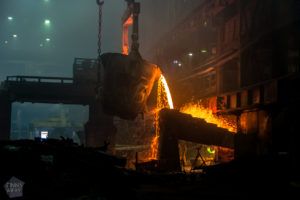 Nornickel hosted visits to Medvezhy Ruchey open pit and to Nornickel Copper Plant. The 420 meters deep pit with a road circulating it is an impressive sight. It has been a source of copper-nickel ore since 1945, which makes it remarkably old, but the pit still has around 20 years mine-life left. In the Nornickel copper plant we made a factory tour and got to see parts of the manufacturing process from really close range from the factory floor, which was a pretty amazing experience actually.
Nornickel hosted visits to Medvezhy Ruchey open pit and to Nornickel Copper Plant. The 420 meters deep pit with a road circulating it is an impressive sight. It has been a source of copper-nickel ore since 1945, which makes it remarkably old, but the pit still has around 20 years mine-life left. In the Nornickel copper plant we made a factory tour and got to see parts of the manufacturing process from really close range from the factory floor, which was a pretty amazing experience actually.
How to get there?
Keen on exploring the Arctic Siberia in the Taymyr Peninsula? Unfortunately that is not too easy on your own at least. Not (just) because of the arctic weather conditions, but because of the fact that Norilsk and Dudinka belong to the so called closed cities of Russia. This means that there are major travel restrictions, especially for foreigners. To go there, a special permit is required, and to get that, you need to apply well ahead and have a good reason and invitation for the visit.
There is no railway or highway connecting Norilsk and Dudinka with other cities in the south (Krasnoyarsk is 1 500 km south of Norilsk, so the distances are huge). Basically the only way to get there and away is by plane, so these cities truly are isolated. That is why the locals call “elsewhere in Russia” as “the mainland”. The Norilsk Airport, also called Alykel Airport, has regular flights from major cities in Russia like Moscow, Saint Petersburg, Krasnoyarsk and Novobirsk. Still, it’s possible to get stuck in Norilsk during the winter, as the airport can be closed down for days, or even weeks sometimes, due to the extreme weather conditions. Flight time from Moscow to Norilsk is four hours, and the time difference between the cities is as much as four hours also.
There actually once was a plan to build a railway from Norilsk to Moscow, and for that a large railway station was built in Norilsk. However, the project was never completed, and the only railway from Norilsk leads to Dudinka, and to nearby Talnakh and Kayerkan industrial villages east from Norilsk. This short railway was originally used for carrying both cargo and passengers, but after the paved highway connecting Norilsk and Dudinka was built in early 1990’s, the railroad has only been used for cargo transportation.
Follow up Siberia – what happens next?
 This press trip was the first round of the Follow up Siberia project. There are three more rounds to come this year, and participants to them are chosen among those, who take part in the Follow up Siberia on-line competition by sending a photo or video of something that reminds them of Siberia in their own home town. The competition is open to everyone (not only for travel bloggers), so why not to check out the rules from Follow up Siberia page and participate! The next round will be organized in Krasnoyarsk in August, so the selected participants will get to know the warm summer of southern Siberia!
This press trip was the first round of the Follow up Siberia project. There are three more rounds to come this year, and participants to them are chosen among those, who take part in the Follow up Siberia on-line competition by sending a photo or video of something that reminds them of Siberia in their own home town. The competition is open to everyone (not only for travel bloggers), so why not to check out the rules from Follow up Siberia page and participate! The next round will be organized in Krasnoyarsk in August, so the selected participants will get to know the warm summer of southern Siberia!
The aim of the project is to introduce Siberia to the world as a modern destination, and to refute the common stereotypes and cliches that there are about Siberia. It’s also about cultural exchange and learning about different traditions around the world. The final goal of the project is the 29th Winter Universiade, organized in Krasnoyarsk in March 2019. Part of the participants of the earlier Follow up Siberia rounds will be invited to participate the Universiade, which for sure will be fantastic experience!
Euronews, the media partner of Follow up Siberia project, was documenting our visit to Siberia. There was also bunch of local media taking photos and videos and making interviews. All this was new to us, and have to admit that it felt a bit weird to be in front of camera all the time instead of behind it, but Euronews managed to shoot a brilliant news video about the trip, check it out here!
Once more, warm thanks to Follow up Siberia organization for inviting us to Siberia, and wishing all the best for the next rounds to come! And thanks for the great company to the fellow travelers with whom we got to explore Norilsk and Dudinka; Raymond “Man On The Lam” from Canada, Milos from Serbia, George from Lebanon, Vikram from India and Mahmud from Egypt, it was nice meeting you all!




